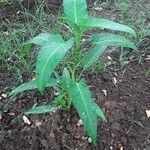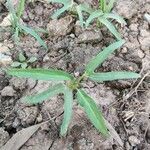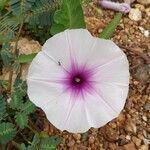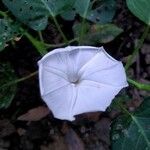Glabrous perennial or sometimes annual herb. Stems many from a woody base, thick, semisuc-culent, terete or striate, hollow or spongy, rooting at nodes, trailing on mud or floating on water, up to 3 m long, sometimes hairy at nodes. Leaves very variable, ovate to triangular or linear, 30-150 x 10-90 mm, apex acute to obtuse, base truncate, cordate to hastate and auriculate, margin entire or dentate; petiole thick, 30-250 mm long. Peduncles axillary, 10-140 mm long, cymosely 1-to few-flowered; pedicels 20-65 mm long; bracts narrow, acute, 1.5-2 mm long. Sepals coriaceous with thin, pale margins, sometimes verrucose, subequal, ovate-oblong to ovate-elliptic, obtuse or acute, 6-12 mm long. Corolla funnel-shaped, purple, pink or white, often with a purple eye, rarely entirely white, 25-75 mm long, limb 45-50 mm in diameter, narrow tube somewhat constricted at place of insertion of filaments. Capsule ovoid, 8-10 mm long. Seeds densely pubescent.
Herbs annual, terrestrial and repent or floating; axial parts glabrous. Stems terete, thick, hollow, rooting at nodes. Petiole 3-14 cm, glabrous; leaf blade variable, ovate, ovate-lanceolate, oblong, or lanceolate, 3.5-17 X 0.9-8.5 cm, glabrous or rarely pilose, base cordate, sagittate or hastate, occasionally truncate, margin entire or undulate, apex acute or acuminate. Inflorescences 1-3(-5)-flowered; peduncle 1.5-9 cm, base pubescent; bracts squamiform, 1.5-2 mm. Pedicel 1.5-5 cm. Sepals subequal, glabrous; outer 2 ovate-oblong, 7-8 mm, margin whitish, thin, apex obtuse, mucronulate; inner 3 ovate-elliptic, ca. 8 mm. Corolla white, pink, or lilac, with a darker center, funnelform, 3.5-5 cm, glabrous. Stamens unequal, included. Pistil included; ovary conical, glabrous. Stigma 2-lobed. Capsule ovoid to globose, ca. 1 cm in diam., woody, tardily dehiscent or ?indehiscent. Seeds densely grayish pubescent, sometimes glabrous. 2n = 30*.
Annual or perennial herb; stems prostrate or floating, thick, semi-succulent, 2–3 m. long, rooting at the nodes, glabrous.. Leaf-blade very variable, narrowly to broadly triangular or linear-oblong, 3–15 cm. long, 0.5–9 cm. wide, acute, acuminate or rarely obtuse at the apex, truncate, cordate or rarely rounded at the base or sagittate to hastate; petioles 3–25 cm. long.. Peduncle 1–few-flowered, 1–14 cm. long; pedicels 2–6.5 cm. long.. Sepals ovate or ovate-elliptic, 6–12 mm. long, 3–6 mm. wide, blunt or ± acute, sometimes ± tuberculate, margins thin and pale.. Corolla funnel-shaped with a narrow tube, purple or pink or white with a deeper centre, (2.5–)4.5–7.5 cm. long.. Capsule globose, 8–10 mm. in diameter.. Seeds densely pubescent.
Kangkong is a creeping sweet potato like plant. It has hollow stems and can float on water. The leaves are green and are normally not divided like some sweet potato leaves, but the shape and size varies a little between different kinds. The trumpet shaped flower looks like a sweet potato flower and is normally white. The runners develop roots at the nodes and also branch. This branching increases when tips are picked off. Some variation in leaf shape can be observed. Leaf shape is less variable than in the related sweet potato, but narrow and broad leafed kinds occur. White and green stemmed kinds occur. Green stemmed kinds have more cold tolerance than white stemmed.
Vines; stems hollow, rooting at the nodes, procumbent on wet ground or floating on water, glabrate. Leaves mostly hastate, the terminal lobe narrowly triangular or lanceolate, the basal lobes smaller and spreading or almost absent, 4-12 cm long, apically acute or obtuse, glabrescent. Flowers solitary or in few-flowered cymnes, the inflorescence glabrous; sepals ovate-oblong, subequal, 7 mm long, obtuse or subacute, mucronulate, glabrous; corolla white or purple, 4-5 cm long, funnelform. Fruits capsular, ovoid to globose, 8-10 mm long; seeds densely soft-pilose or glabrous.
Leaf lamina very variable in shape and size, ovate, triangular, ovate-oblong, lanceolate or linear, 3–15 × 1–10 cm., acute, acuminate or rarely obtuse at the apex, truncate, cordate or rounded at the base or sagittate to hastate, entire or coarsely dentate; petiole 3–25 cm. long, thick, glabrous.
Stems several from a stout woody base, prostrate or floating, thick, semi-succulent, 2–3 m. long, rooting at the nodes glabrous or hairy at the nodes.
Inflorescence 1-few-flowered; peduncle 1–14 cm. long, glabrous; pedicels 2–6·5 cm. long, glabrous; bracts minute, narrow, acute, 1·5–2 mm. long.
Sepals ovate or ovate-elliptic 6–12 mm. long, blunt or more or less acute, sometimes more or less tuberculate, margins thin and pale.
Corolla funnel-shaped with a narrow tube, purple or pink or white with a deeper centre, 4–10·5 cm. long.
Nearly glabrous, stems hollow, from a stout woody stock, trailing on mudand rooting at the nodes
Pale or dark red-purple flowers 2-3 in. long.
Capsule globose, glabrous.
Annual or perennial herb.
Seeds densely pubescent.









